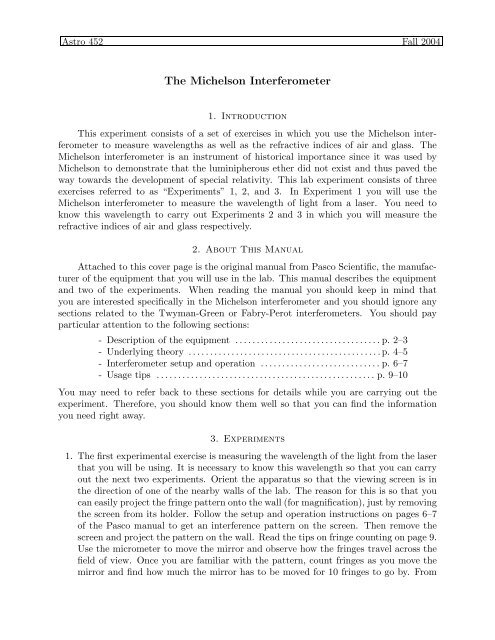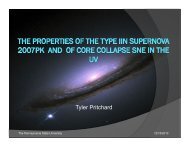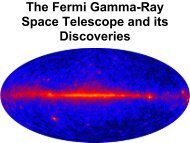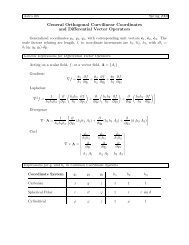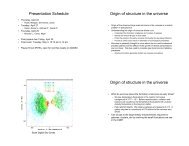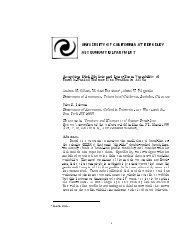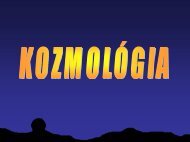The Michelson Interferometer
The Michelson Interferometer
The Michelson Interferometer
You also want an ePaper? Increase the reach of your titles
YUMPU automatically turns print PDFs into web optimized ePapers that Google loves.
Astro 452 Fall 2004<strong>The</strong> <strong>Michelson</strong> <strong>Interferometer</strong>1. IntroductionThis experiment consists of a set of exercises in which you use the <strong>Michelson</strong> interferometerto measure wavelengths as well as the refractive indices of air and glass. <strong>The</strong><strong>Michelson</strong> interferometer is an instrument of historical importance since it was used by<strong>Michelson</strong> to demonstrate that the luminipherous ether did not exist and thus paved theway towards the development of special relativity. This lab experiment consists of threeexercises referred to as “Experiments” 1, 2, and 3. In Experiment 1 you will use the<strong>Michelson</strong> interferometer to measure the wavelength of light from a laser. You need toknow this wavelength to carry out Experiments 2 and 3 in which you will measure therefractive indices of air and glass respectively.2. About This ManualAttached to this cover page is the original manual from Pasco Scientific, the manufacturerof the equipment that you will use in the lab. This manual describes the equipmentand two of the experiments. When reading the manual you should keep in mind thatyou are interested specifically in the <strong>Michelson</strong> interferometer and you should ignore anysections related to the Twyman-Green or Fabry-Perot interferometers. You should payparticular attention to the following sections:- Description of the equipment .................................. p. 2–3- Underlying theory .............................................p. 4–5- <strong>Interferometer</strong> setup and operation ............................ p. 6–7- Usage tips . .................................................. p. 9–10You may need to refer back to these sections for details while you are carrying out theexperiment. <strong>The</strong>refore, you should know them well so that you can find the informationyou need right away.3. Experiments1. <strong>The</strong> first experimental exercise is measuring the wavelength of the light from the laserthat you will be using. It is necessary to know this wavelength so that you can carryout the next two experiments. Orient the apparatus so that the viewing screen is inthe direction of one of the nearby walls of the lab. <strong>The</strong> reason for this is so that youcan easily project the fringe pattern onto the wall (for magnification), just by removingthe screen from its holder. Follow the setup and operation instructions on pages 6–7of the Pasco manual to get an interference pattern on the screen. <strong>The</strong>n remove thescreen and project the pattern on the wall. Read the tips on fringe counting on page 9.Use the micrometer to move the mirror and observe how the fringes travel across thefield of view. Once you are familiar with the pattern, count fringes as you move themirror and find how much the mirror has to be moved for 10 fringes to go by. From
Astro 452 <strong>The</strong> <strong>Michelson</strong> <strong>Interferometer</strong> Fall 2004this information calculate the wavelength of the laser light. Repeat the experiment 4times and take a weighted average of the results and uncertainties. Contemplate thefollowing questions (and write about them in your reports):• Why should you count several fringes instead of just one?• One possible source of error is miscounting the fringes as they go by (e.g., miscountingby 1). What error does this introduce in the final result? What areother sources of error in this measurement?2. <strong>The</strong> second experiment involves the measurement of the refractive index of air, andit is described in detail on pages 13–14 of the Pasco manual. Follow the proceduredescribed there as well as the instructions for the data analysis. At the end answerthe questions. As in Experiment 1, you may find it easier to project the fringe patternon the wall rather than on the small screen.3. <strong>The</strong> second experiment involves the measurement of the refractive index of glass, andit is described in detail on pages 15–16 of the Pasco manual. Follow the proceduredescribed there as well as the instructions for the data analysis. As in Experiment 1,you may find it easier to project the fringe pattern on the wall rather than on the smallscreen. Consider possible sources of error and estimate their magnitude. Propagatetheir effect to see how they affect the final result.4. Lab ReportsAs usual, your lab reports should include a brief description of the experiment. <strong>The</strong>reis no need to repeat any of the details given in the lab manual. However, you shoulddescribe anything unexpected that you encountered and deviations from the manual, ifthere were any. Report all of your data and make sure that you have answered all of thequestions in the lab manual.
Precision <strong>Interferometer</strong> 012-05187BData Analysis1. With the above measurements, compute the index of refraction of glass from thefollowing equation:n g = − [(mλ/2t) − n a(1 − cos θ)] 2 + (n a sin θ) 22 [(mλ/2t) − n a (1 − cos θ)], (1)where t is the thickness of the glass plate, λ is the wavelength of the laser light, m isthe number of fringe transitions that you counted as the glass block was rotated frombeing perpendicular to the beam to an angle θ, and n a is the refractive index of air.2. Show that the above expression can be simplified, with sensible approximations, tothe following:(1 − cos θ) [1 − (mλ/2t)]n g = . (2)(1 − cos θ) − (mλ/2t)What are the approximations that you need to make to accomplish this? Why arethey “sensible”? Compute the index of refraction of glass with equation (2) as well aswith equation (1) to illustrate that the answers are very similar.3. Using equation (2) derive an expression for the uncertainty in n g resulting from asmall error in the measured rotation angle of the glass block, δθ, and from a smallerror in the number of fringe transitions, δm. Use this expression to estimate theuncertainty in n g .For Extra Credit: derive equation (1).This will earn you an additional 25% of the points of the lab report, but you shouldthink carefully whether it is worth investing any time in this exercise. You can goabout it as follows:(a) Draw a figure showing the path of the beam as it travels from the beam splitter,through the glass block at an arbitrary inclination angle θ, and on to the reflector.(b) Compute the optical path length of the beam as it travels from the beam splitter,through the glass block at an arbitrary inclination angle θ, on to the reflector, andthen all the way back. Pay attention to the definition of the inclination angle: it isdefined as the angle of incidence of the beam onto the face of the glass block, i.e., theangle between the beam and the normal to the glass surface.(c) Find the change in the optical path length as the inclination angle changes from 0 toan arbitrary value, θ. If this change results in an integer number of fringe transitions,m, then the change in the optical path length should be equal to an integer multipleof the wavelength, mλ. Set the change in optical path length equal to mλ to get anequation for n g .16


